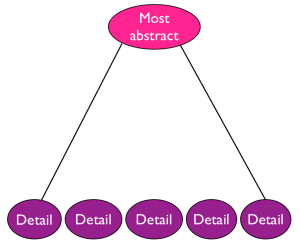NLP Language Technique – Hierarchy of Ideas
In NLP we have lots of cutting edge language techniques that enable smarter communication. One of those NLP techniques is called the Hierarchy of Ideas and it is great for use in mediation and negotiation.
When we use language we talk at different levels of specificity. Sometimes when we talk we talk with a great deal of detail and sometimes we are very abstract in our use of language.
As we know by now the language that we use reflects our thinking, our language is merely the label that we put on our thoughts, so we can say that we actually think at different levels of detail and abstract. Thus the hierarchy of ideas.
Think of a hierarchy with the most abstract, way out idea at the top and the most detailed idea at the bottom and when we speak we talk at different levels on this hierarchy. Sometimes we move up and down the hierarchy during a conversation as we discuss different topics and we each usually have a preference for where we think on the hierarchy, some of us think of things in more detail and some of us are more abstract in our thinking.
 Normally people who have a preference for thinking at a more abstract level tend to rise up the rank in organisations. If you think about it we need abstract thinkers, big picture thinkers running our companies, so that makes sense. Shop floor workers and professions like accountants prefer to think at a more detailed level.
Normally people who have a preference for thinking at a more abstract level tend to rise up the rank in organisations. If you think about it we need abstract thinkers, big picture thinkers running our companies, so that makes sense. Shop floor workers and professions like accountants prefer to think at a more detailed level.
Very often conflict can arise in communication when people are thinking and speaking at different levels on the hierarchy. More often than not the more detailed someone is in their thinking the more likely that they are going to be in conflict with someone else.
If you are negotiating or mediating between two conflicting parties you will be able to gain agreement by moving the two parties up and down the hierarchy in their thinking.
In order to change the level of thinking up the hierarchy you can ask “for what purpose?” Or “for what intention?” Or “what is this an example of?” Or “what will that get for you?”
In order to change the level of thinking down the hierarchy you can ask “what are examples of this?” or “what specifically?”
So say for example two neighbours are arguing about the fact that one of them lets call him A, parks his car directly opposite the other one, B’s drive making it difficult for B to get his car in the drive.
A says he parks his car there because it is closest to his own drive making it the most convenient place for him to park.
B says that it is ridiculous to park there because A could park fifteen feet further down the road which would mean that B would have no problem getting in his drive.
Lets talk to A first of all.
We ask A, “What is the purpose in you parking your car directly opposite A’s drive?” A says I park my car there because it is closest to my own drive making it the most convenient place for me to park.”
We ask “what is the intention for you of making things convenient?”
A says “To make things easier for me”
“For what purpose?”
“To make me less tired.” Says A.
“What will being less tired get for you?”
A replies “it will make me happy.”
“What is the purpose for you of being happy?”
“So that I can survive” A says.
Now let me tell you. If you keep asking these type of questions that take thinking up the hierarchy eventually you will always get to a word or a phrase that is similar to existence, like “survival.”
Lets work with B now.
We ask B, “What is the purpose for you in asking B to park his car further down the road?”
B says, “because it is stressing me out! It takes me ages to get my car on my drive! If he parked further away I wouldn’t be stressed”
“What is stress an example of?”
B replies, “Anger”
“What is the purpose for you of being angry?”
“So that I can let go and be free” B says.
“What is the purpose for you of being free?”
B says, “So that I can be happy”
“What is the purpose for you of being happy?”
“Existence” replies B.
So there we have it both have said that the intention for their actions is their happiness and at the top of the hierarchy both have said that the ultimate purpose for their actions is “Existence” or “Survival”.
At this stage we would get them both to recognise that they have both said the same thing, and this is the beginning of agreement. All we would need to do now is to move them back down the hierarchy whilst holding the agreement that we have at the top!
Eg To A,”Given that you both have the same intention. Is there some way we could work this out where you could both be happy?”
What a tremendous technique this is, it works every time.
We discuss it further in our NLP training.
We train people in NLP at all levels from beginner through to expert and we also provide executive NLP coaching and mentoring services.

